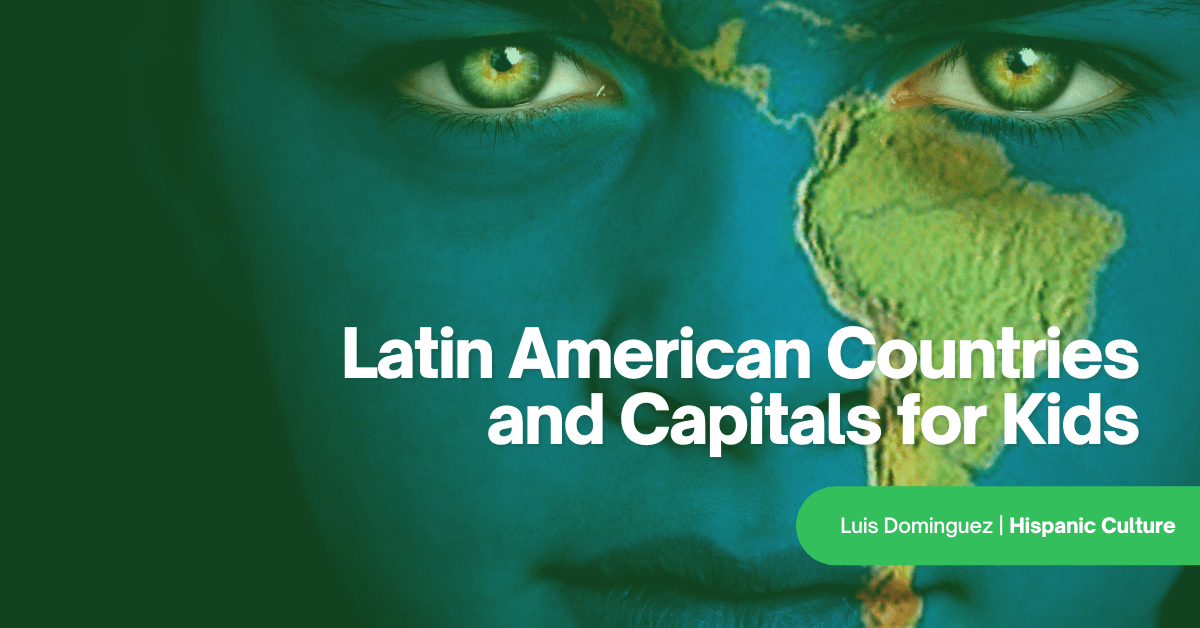
Latin American Countries and Capitals for Kids (Spanish and English)
You’ve found the ultimate Latin American Capitals resource for your lesson!
A good way to teach geography for kids is to help them to have fun while they do it. To achieve that, singing songs and memorizing mnemonic devices are smart strategies.
Keep reading to learn which are the countries and capitals of Latin America, interesting facts about each one of the capital cities, a couple of fun songs about them, and a smart trick to help you memorize them.
Join 559 million people on the planet who speak Spanish!
Sign up for your free trial Spanish class today.
TABLE OF CONTENTS
- Spanish-Speaking Countries and Capitals
- Latin American Capitals in Spanish for Kids
- Latin America Political Map with Capitals
- Latin America Countries and Capitals Song
- Capitals Mnemonic for Latin American Countries
- Latin American Capitals and Countries Quiz
- Learn the Latin American Capitals and Have Fun!
Spanish-Speaking Countries and Capitals
There are 20 countries and one unincorporated territory where Spanish is an official or national language. The list of Spanish-speaking countries include Spain, all the Latin American American nations minus Brazil, and Equatorial Guinea in Africa.
Latin America is a region with a brief but captivating history and a fascinating and colorful culture. Learning about Latin America is always an interesting experience and today we’re focusing on the capitals of each Latin American country.
Latin American Capitals in Spanish for Kids
I’ve divided Latin American nations into four categories to make it easier for you to learn them and I’m including the capital cities names in Spanish and English, as well as some interesting facts about each one of them.
North America:
There’s an extended perception that Mexico forms part of Central America, but in reality the nation that gave to the world the Mariachi and the delicious tacos is the only Latin American country in North America.
Mexico
With a population of over 130 million people, Mexico is the country with the most Spanish-speaking people in the world.
Capital’s name in Spanish: Ciudad de México
Capital’s name in English: Mexico City
Interesting Facts:
- It’s the most populated city in the Western Hemisphere.
- It was built on top of a lake.
- It’s the oldest capital in the Americas.
Central America
Central America is formed by 7 countries, but only 6 of them have Spanish as their official language (Belize is the exception). The region extends from Guatemala in the North to Panama in the South.
Guatemala
Inhabited for the last 20,000 years, Guatemala is a country with great history and amazing diversity.
Capital’s name in Spanish: Ciudad de Guatemala
Capital’s name in English: Guatemala City
Interesting Facts:
- It’s the largest city in Central America.
- You can see 4 volcanoes from the city.
- It was founded after an earthquake destroyed the previous capital.
El Salvador
El Salvador is both the smallest country in Central America and the most populated country in the whole of the Americas. It’s also the only Central American nation without a Caribbean coastline.
Capital’s name in Spanish: San Salvador
Capital’s name in English: San Salvador
Interesting Facts:
- San Salvador means “Holy Savior.”
- It was founded in 1525 by a Spanish Conquistador.
- In 1528 the city was moved 20 miles southwest to its present site.
Honduras
Discovered by Cristopher Columbus, Honduras has an area of 112,090 square km and just over 9 million people.
Capital’s name in Spanish: Tegucigalpa
Capital’s name in English: Tegucigalpa
Interesting Facts:
- Tegucigalpa was a colonial center of silver and gold mining.
- It hosts 25 foreign embassies.
- Tegucigalpa means “place of residence for the noble.”
Nicaragua
Nicaragua is the largest country in Central America and it’s also home to the region’s largest lake: Lake Nicaragua.
Capital’s name in Spanish: Managua
Capital’s name in English: Managua
Interesting Facts:
- Over a quarter of Nicaragua’s population lives in Managua.
- Managua’s center was destroyed by an earthquake in 1972.
- Managua means “surrounded by water” in the ancient Nahuatl language.
Costa Rica
Known as the “Latin American Switzerland” due to its lack of a standing army, Costa Rica is home to 5% of the world’s biodiversity and an ecotourism hotspot.
Capital’s name in Spanish: San José
Capital’s name in English: San José
Interesting Facts:
- It was founded in 1737.
- It was a trading center for coffee plantations.
- It’s in the middle of a tropical rainforest.
Panama
Panama is worldwide known for its famed canal and for being the only place in the world where you can see the sun rise on the Pacific Ocean and set on the Atlantic Ocean.
Capital’s name in Spanish: Ciudad de Panamá
Capital’s name: Panama City
Interesting Facts:
- Panama City is the only city in the world with a rain forest within the city.
- It was destroyed in 1671 by a band of pirates.
- It’s home to 5 of the 10 tallest buildings in Latin America.
South America
South America is home to 12 countries plus the French Guiana and 9 of them have Spanish as their official language.
Colombia
With 50 million people, Colombia is the second country with more Spanish-speaking people in the world. The Spanish spoken in Colombia is widely considered as the best or purest in the world.
Capital’s name in Spanish: Bogotá
Capital’s name in English: Bogota
Interesting Facts:
- There are no seasons in Bogota.
- It hosts the biggest theater festival in the world.
- It’s the 5th largest city in Latin America.
Venezuela
The Bolivarian Republic of Venezuela is the 33rd largest country in the world and home to 30 million Spanish speakers.
Capital’s name in Spanish: Caracas
Capital’s name in English: Caracas
Interesting Facts:
- Its official name is Santiago de León de Caracas.
- The Central University of Venezuela in Caracas is a UNESCO World Heritage Site.
- It has the tallest twin towers in Latin America: “Parque Central.”
Ecuador
Ecuador is both the closest country to space and the only country in the world to be named after a geographical feature.
Capital’s name in Spanish: Quito
Capital’s name in English: Quito
Interesting Facts:
- Its official name is San Francisco de Quito.
- It was the first city to be declared a UNESCO World Heritage Site.
- It has the best preserved historical center in Latin America.
Peru
The cradle of the ancient Inca civilization, Peru is home to one of the New Seven Wonders of the World (Machu Picchu) and some of the best restaurants in the world.
Capital’s name in Spanish: Lima
Capital’s name in English: Lima
Interesting Facts:
- Its nickname is “The City of Kings.”
- It’s considered the Gastronomic Capital of Latin America.
- After Cairo in Egypt, Lima is the second largest city built on a desert.
Bolivia
Bolivia is a landlocked country (that means that it has no access to the sea), and it has 37 official languages, Spanish being just one more of them.
Capital’s name in Spanish: La Paz
Capital’s name in English: La Paz
Interesting Facts:
- Sitting at 3,650 m above sea level, La Paz is the highest city in the world.
- Its full name is Nuestra Señora de La Paz (Our Lady of Peace).
- It has the longest and highest cable car system in the world.
Chile
Chile is a country famous for its wines, its wonderful writers, and for being one of the longest countries in the world.
Capital’s name in Spanish: Santiago
Capital’s name in English: Santiago
Interesting Facts:
- About one third of Chile’s population lives in Santiago.
- The Costanera Gran Torre is the tallest building in South America.
- It’s home to the oldest university in all of the Americas.
Argentina
With over 45 million people, Argentina is the 4th country with more Spanish speakers in the world. It’s the home of tango, gauchos, and great football (soccer) players.
Capital’s name in Spanish: Buenos Aires
Capital’s name in English: Buenos Aires
Interesting Facts:
- Buenos Aires has the widest street in the world: Avenida 9 de julio.
- It has the most bookshops per capita in the world.
- Its metro system is the oldest in Latin America.
Uruguay
Uruguay is the smallest Spanish speaking country in South America and is home to more cows than people.
Capital’s name in Spanish: Montevideo
Capital’s name in English: Montevideo
Interesting Facts:
- It’s home to nearly 80% of the country’s entire population.
- It hosted every match of the first ever FIFA World Cup in 1930.
- It has the highest quality of life of any city in Latin America.
Paraguay
Bordering Bolivia, Brazil, and Argentina, Paraguay is a bilingual nation that holds the largest Navy of any landlocked country in the world.
Capital’s name in Spanish: Asunción
Capital’s name in English: Asuncion
Interesting Facts:
- Its official name is Nuestra Señora Santa María de la Asunción (Our Lady, Holy Mary of the Assumption).
- It has 1.2 million inhabitants.
- Founded in 1537, Asuncion is one of the oldest cities in South America.
Brazil
Brazil is the only Latin American country that doesn’t speak Spanish, but it’s also the largest and most populated one.
Capital’s name in Spanish: Brasilia
Capital’s name in English: Brasilia
Interesting Facts:
- Brasilia was built in just 41 months from 1956 to 1960.
- It was mostly designed by famous Brazilian architect Oscar Niemeyer.
- Brasilia is built in the shape of an airplane.
Caribbean Countries and Capitals of Latin America
The Caribbean is home to 13 countries, of which only two are considered part of Latin America: Cuba and Dominican Republic. Puerto Rico which is an unincorporated territory of the United States is also considered part of Latin America.
Cuba
Cuba is the largest island in the Caribbean and one of the last communist countries still remaining in the world.
Capital’s name in Spanish: La Habana
Capital’s name in English: Havana
Interesting Facts:
- Havana is a UNESCO World Heritage Site.
- It hosts the biggest ballet school in the world.
- It’s more than 500 years old (founded in 1519).
Dominican Republic
The Dominican Republic was discovered by Christopher Columbus in his first trip in 1492. Today it shares the Hispaniola island with Haiti.
Capital’s name in Spanish: Santo Domingo
Capital’s name in English: Santo Domingo
Interesting Facts:
- Santo Domingo is the oldest city in the Americas.
- It’s the largest metropolitan area in the Caribbean.
- Its port is the 4th busiest seaport in the Western Hemisphere.
Puerto Rico
Although not properly a country, Puerto Rico is considered part of Latin America due to its history and culture.
Capital’s name in Spanish: San Juan
Capital’s name in English: San Juan
Interesting Facts:
- It’s the second oldest capital city in the Americas.
- It’s the oldest city on US territory.
- It’s a UNESCO World Heritage Site.
Latin America Political Map with Capitals
It’s time to have a look at a map with all of the Latin American countries and their capitals.
Latin America Countries and Capitals Song
A fun way to learn all the countries and capitals of Latin America is by singing these two catchy songs, which sadly don’t include the Caribbean islands:
Capitals Mnemonic for Latin American Countries
To help you remember the capitals of all the Latin American countries you can use the following mnemonic device:
Most Gorillas Like Telling Silly Mammoth Stories in the Park, But Also Love Singing Country Songs and Having Quite Big Meals Before Sunset.
(Mexico City, Guatemala City, Lima, Tegucigalpa, San Salvador, Managua, San Jose, Panama City, Buenos Aires, Asunción, La Paz, Santiago, Caracas, Santo Domingo, Havana, Quito, Brasilia, Montevideo, Bogota, San Juan).
Latin American Capitals and Countries Quiz
It’s time to test your knowledge of Latin American countries and capitals.
1. Capital of Bolivia:
- Bogota
- Caracas
- La Paz
- Montevideo
2. Capital of Cuba:
- Havana
- Santo Domingo
- Buenos Aires
- Tegucigalpa
3. Capital of Argentina:
- Santiago
- Montevideo
- Brasilia
- Buenos Aires
4. Capital of Nicaragua:
- San Jose
- Panama City
- Managua
- Tegucigalpa
5. Capital of Peru:
- Asuncion
- Bogota
- Santiago
- Lima
6. Capital of Uruguay:
- Montevideo
- La Paz
- Buenos Aires
- Santiago
7. Capital of Puerto Rico:
- San Jose
- Santo Domingo
- San Juan
- Tegucigalpa
8. Capital of Chile:
- Lima
- Santiago
- Buenos Aires
- Caracas
9. Capital of Colombia:
- Caracas
- Bogota
- Buenos Aires
- La Paz
10. Capital of Honduras:
- San Jose
- Caracas
- Managua
- Tegucigalpa
Learn the Latin American Capitals and Have Fun!
Learning Latin American geography can be very fun if you use different strategies such as a cool song or a mnemonic device like the ones shown above. Remember that when you learn new details about a country, it’s like opening a window into its culture. Same thing happens when you learn a language.

Join one of the 40,000 classes that we teach each month and you can experience results like these…

“This is the best way for your kid to learn Spanish. It’s one-on-one, taught by native Spanish speakers, and uses a curriculum.”
– Sharon K, Parent of 3

“It’s a great way to learn Spanish, from native Spanish speakers in a 1-on-1 environment. It’s been fairly easy to schedule classes around my daughter’s other classes. The best value for us has been ordering multiple classes at a time. All the instructors have been great!”
– Cindy D, Parent of 3

“HSA offers very affordable, quality, one on one classes with a native speaker. My son has greatly benefited from taking classes. We have seen his confidence increase as well as his pronunciation improve, because he learns from a native Spanish speaker. HSA has quick, personal customer service. Our family has been very pleased with our experience so far!”
– Erica P. Parent of 1
Want more educational Hispanic content? This is for you!
- How to Create a Daily Homeschooling Routine Using Spanish Fluency Games for Kids
- Boost Your Child’s Spanish Skills with These Family-Friendly Games
- How to Help Your Child Speak Spanish with Confidence (Without Feeling Embarrassed!)
- The Best Spanish Learning Podcasts for Kids
- Spanish for Middle Schoolers: The Perfect Age to Start (Here’s Why!)
- How to Make Learning Spanish Fun for Kids: 7 Engaging Activities
- Why Early Spanish Learning Gives Your Child a Head Start in School
- The #1 Mistake Parents Make When Teaching Kids Spanish (And How to Avoid It)
Answer Key
- 1. c
- 2. a
- 3. d
- 4. d
- 5. d
- 6. a
- 7. c
- 8. b
- 9. b
- 10. c
- 50 Useful Spanish Transition Words for Everyday Speech and Writing - January 30, 2025
- Master the 18 Spanish Tenses (and Take Our Cheat Sheet With You) - January 23, 2025
- A Guide to Double Negatives in Spanish - December 18, 2024






